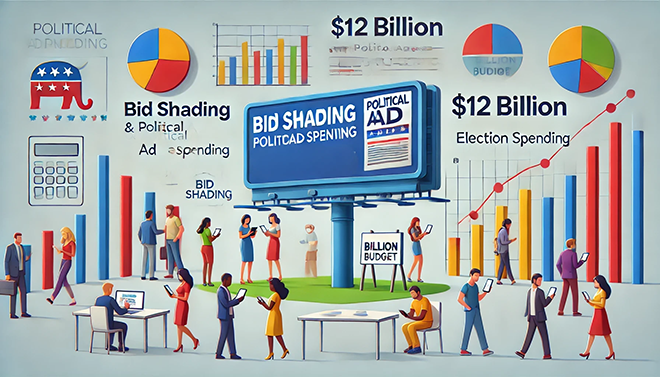
Explore how bid shading in political advertising affects publishers’ revenue, the associated risks, and strategic measures to mitigate these impacts during an election cycle with high political budgets.
Political advertisers are forecasted to spend over $12 billion across all channels during the 2024 election cycle, marking the highest spend in U.S. history, according to eMarketer. While a significant portion of that budget will go to linear TV, digital advertising remains a critical battleground.
Election campaigns are turning to advanced techniques like bid shading to stretch their dollars in this high-stakes environment. But what does bid shading mean for publishers? Let’s dig into how this tactic impacts publishers, the challenges it presents, and how to navigate these waters during this unprecedented election cycle.
What is Bid Shading?
Bid shading might sound like some covert operation, but it’s actually a savvy strategy media buyers use in digital ad auctions. Imagine you’re at an auction, but instead of bidding wildly, you have an algorithm whispering the optimal bid in your ear.
This algorithm analyzes historical pricing data, current market conditions, and the value of the impression to tweak bids just enough to win ad impressions without overpaying. The method is especially crucial in situations like political advertising where budgets, although large, need to be spent efficiently.
Example:
Picture a political campaign aiming to secure an ad slot. Without bid shading, they bid $10 and pay the full amount. But, with bid shading, the algorithm suggests $7.50 based on past data, saving $2.50 while still winning the spot and potentially saving the advertiser 25% on that impression.
The Impact of High Political Budgets on Publishers
With political budgets hitting an all-time high, this influx of ad spend can be both a golden opportunity and a potential headache for publishers.
The Upside:
- Increased Demand: More political dollars chasing your inventory means heightened competition, which typically drives up demand and fill rates.
- Revenue Boost: Those previously unsold ad slots? They’re now hot commodities, filling up quickly and boosting your bottom line.
The Downside:
- Revenue Volatility: While demand surges, bid shading introduces a layer of unpredictability as bids are adjusted downward, making revenue streams less predictable.
- Inventory Devaluation: As campaigns use bid shading to cut costs, the perceived value of your ad impressions might take a hit, impacting long-term revenue strategies.
Navigating the Risks of Bid Shading
Bid shading isn’t just a double-edged sword — it’s a whole cutlery set. Here are the risks you need to watch out for and how to handle them:
Lower CPMs:
Bid shading typically results in lower cost-per-thousand impressions (CPMs). Some publishers have reported CPM drops of up to 20% due to bid shading. This is a direct hit to your revenue as bids are systematically adjusted to lower amounts.
What to Do:
Consider implementing dynamic price floors that adapt to market conditions in real time. This ensures bids won’t drop below a certain level, protecting your revenue.
Inconsistent Revenue Streams:
The dynamic nature of bid shading means your revenue from political ads can fluctuate wildly, complicating forecasting and planning.
What to Do:
Leverage advanced yield management tools to analyze historical data and market trends. This helps you understand and anticipate the effects of bid shading, optimizing your inventory pricing and placement.
Competitive Pressure:
With multiple campaigns vying for ad space, the pressure to lower prices further increases, risking a race to the bottom.
What to Do:
Enhance your auction strategies with techniques like header bidding. By involving multiple demand sources, you can drive up competition for your inventory, balancing out the downward pressure from bid shading.
Making Bid Shading Work for You
Bid shading isn’t all doom and gloom—there’s a silver lining if you play your cards right. Here’s how to turn bid shading into an advantage:
Leverage Advanced Analytics:
Investing in tools that provide deep insights into bidding patterns can help publishers adjust their strategies in real time and identify opportunities to maximize revenue.
Enhance First-Party Data:
Rich, accurate data about audience segments can command premium prices, even in a bid-shaded environment. Investing in data collection and analysis can increase the value proposition for advertisers.
Dynamic Price Floors:
Setting smart, dynamic price floors can help you maintain control over your inventory pricing. Adjust these floors based on real-time market conditions, like time of day, user demographics, and current events to prevent your CPMs from dropping too low.
Auction Strategies:
Don’t just rely on traditional auction setups. Incorporate header bidding to get multiple demand sources competing for your ad space. Increase competition for inventory and mitigate the impact of bid shading from any single source by relying on multiple SSPs and ad exchanges. This improves the likelihood of higher bids, even with bid shading in play.
Yield Management:
Invest in robust yield management tools and expertise. These tools help you make data-driven decisions about your ad inventory, optimizing pricing and placement to counteract the effects of bid shading.
Collaboration with Buyers:
Build strong relationships with your advertisers. Educate them about the value of your premium inventory and work together to establish fair pricing and bidding practices. This collaborative approach can lead to more stable and beneficial outcomes for both parties.
When in Rome Leverage Bid Shading to Your Advantage
Bid shading is here to stay, especially in high-budget political advertising cycles. Publishers who adapt and strategically manage their ad inventory can thrive, capturing the full potential of these high-budget opportunities.
While bid shading presents both opportunities and challenges, strategic measures can mitigate risks and maximize revenue. Implementing dynamic pricing, enhancing auction strategies, optimizing yield management, and fostering collaboration with buyers is key to navigating bid shading complexities and staying competitive.
Not all of the predicted $12 billion election cycle budgets will be subject to bid shading. Direct deals, bypassing programmatic auctions, will also play a significant role. Publishers offering unique value propositions, like highly engaged audiences or brand-safe environments, can command premium prices despite bid shading tactics.